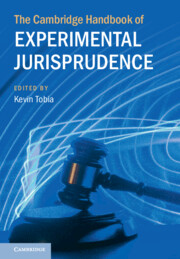Book contents
- The Cambridge Handbook of Experimental Jurisprudence
- The Cambridge Handbook of Experimental Jurisprudence
- Copyright page
- Contents
- Contributors
- Acknowledgments
- Dedication
- Part I Foundations and Theory
- 1 Introduction
- 2 Psychology and Jurisprudence across the Curriculum
- 3 Holmes, Legal Realism, and Experimental Jurisprudence
- 4 The Empirical Component of Analytic Jurisprudence
- 5 The Limits of Experimental Jurisprudence
- 6 Competing Conceptual Inferences and the Limits of Experimental Jurisprudence
- 7 The Contours of Bias in Experimental Jurisprudence
- 8 Experimental Jurisprudence and Doctrinal Reasoning
- 9 Law and Morality
- 10 Legal Constraint
- Part II Introductions
- Part III Applications
- Index
- References
4 - The Empirical Component of Analytic Jurisprudence
from Part I - Foundations and Theory
Published online by Cambridge University Press: 17 May 2025
- The Cambridge Handbook of Experimental Jurisprudence
- The Cambridge Handbook of Experimental Jurisprudence
- Copyright page
- Contents
- Contributors
- Acknowledgments
- Dedication
- Part I Foundations and Theory
- 1 Introduction
- 2 Psychology and Jurisprudence across the Curriculum
- 3 Holmes, Legal Realism, and Experimental Jurisprudence
- 4 The Empirical Component of Analytic Jurisprudence
- 5 The Limits of Experimental Jurisprudence
- 6 Competing Conceptual Inferences and the Limits of Experimental Jurisprudence
- 7 The Contours of Bias in Experimental Jurisprudence
- 8 Experimental Jurisprudence and Doctrinal Reasoning
- 9 Law and Morality
- 10 Legal Constraint
- Part II Introductions
- Part III Applications
- Index
- References
Summary
As a branch of analytic philosophy, jurisprudence, understood as legal philosophy, is often thought to be a nonempirical enterprise. It turns out, however, that unresearched, unsupported, and largely impressionistic empirical assertions have long been a part of the analytic jurisprudential enterprise. Recognizing this is the first step towards examining and testing these empirical assertions. Using the proclivity of ordinary people to obey the law (or not) because of the content-independent existence of law as one example of such an assertion, this chapter explores how that assumption might be tested by experimental and other means, as a prolegomenon to testing the empirical claims and assumptions that have long pervaded even the most traditional jurisprudence.
Information
- Type
- Chapter
- Information
- The Cambridge Handbook of Experimental Jurisprudence , pp. 67 - 78Publisher: Cambridge University PressPrint publication year: 2025
